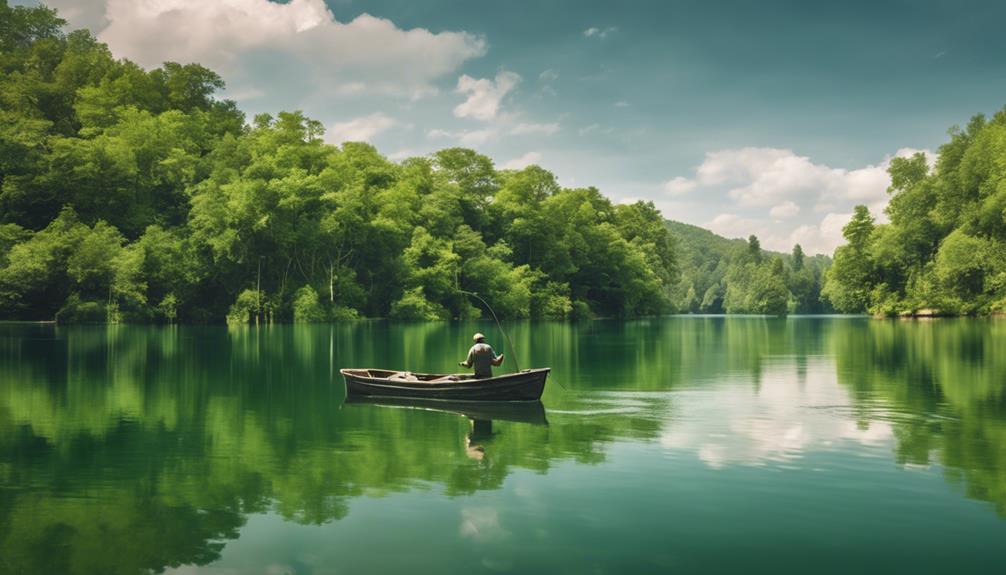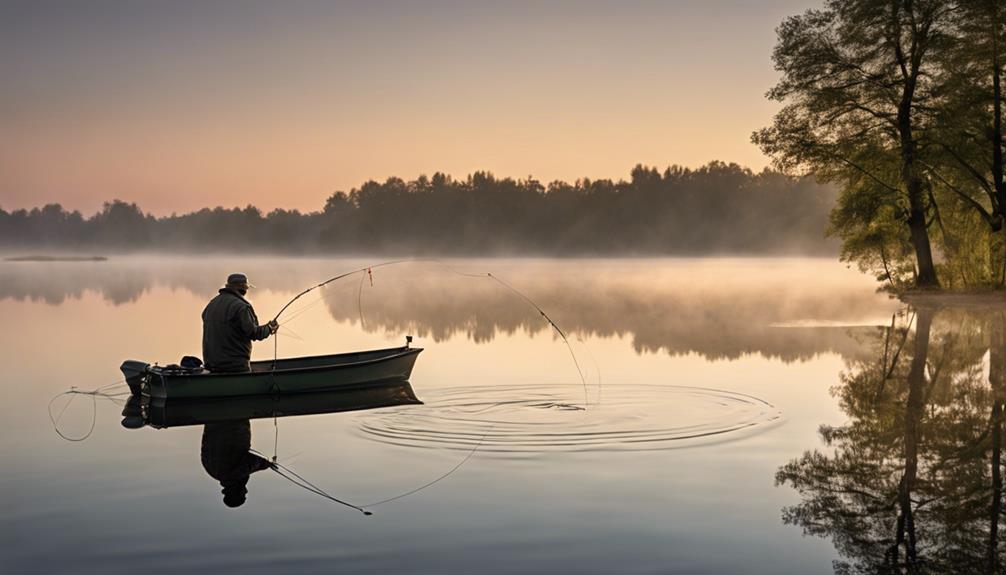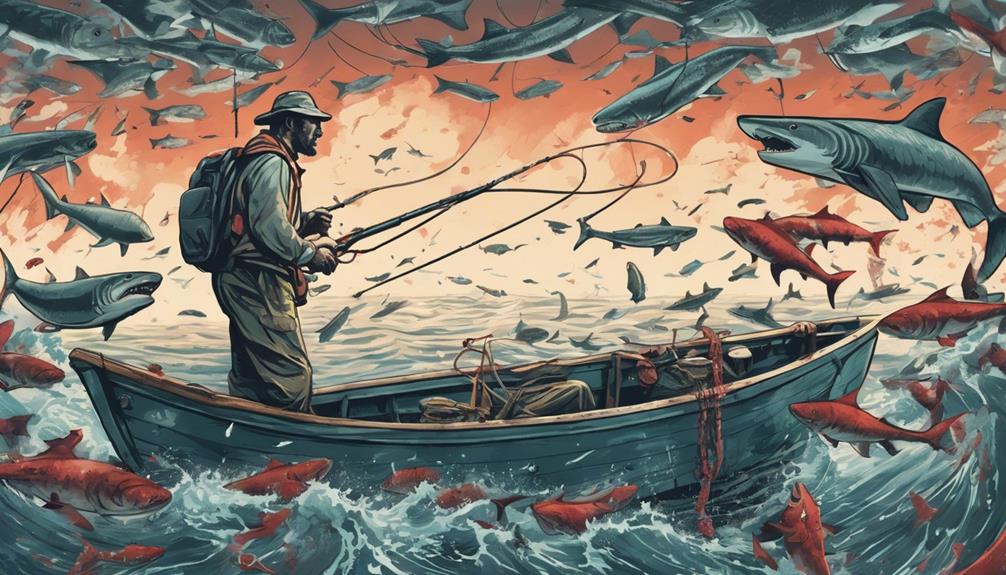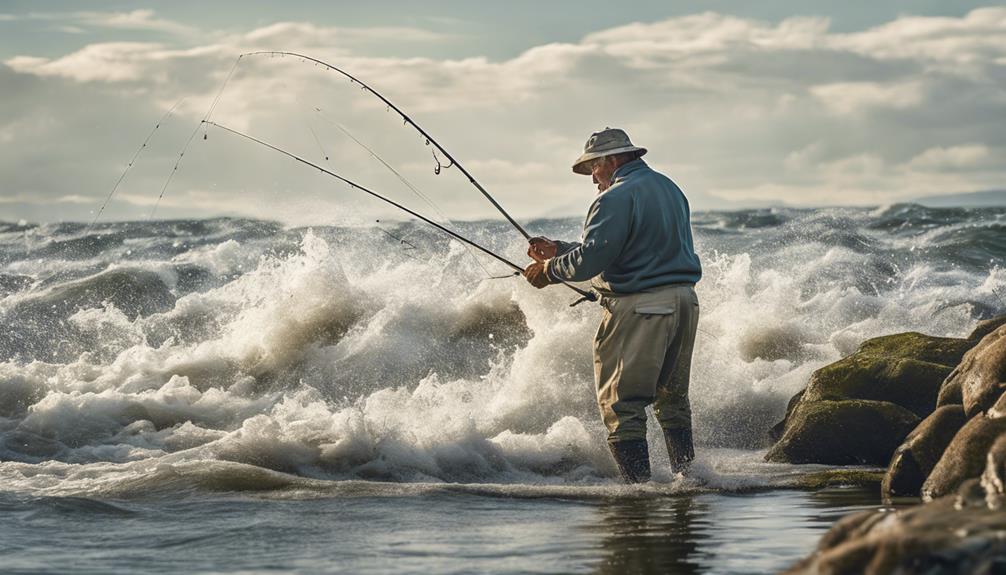You've tried your luck at various spots, but have you considered the depths of the lake?
Discovering effective deep lake fishing techniques can open up a whole new world of possibilities.
From mastering the use of downriggers to understanding the behavior of fish in relation to thermoclines, there are several strategies that can significantly improve your chances of a successful catch.
So, where should you start on this deep-water adventure?
Finding the Right Spot
When looking for the perfect spot to catch fish in deep lakes, start by searching for areas with underwater structures that provide shelter and food for fish. These structures could include submerged trees, rock formations, or underwater vegetation where fish tend to gather. Using sonar technology can greatly assist in locating these underwater structures and schools of fish. By utilizing sonar, you can identify the precise depths and contours of the lake bed, helping you pinpoint the most promising fishing spots.
Once you have identified a promising location, anchoring securely is essential to ensure you can focus on fishing without constantly readjusting your position. Make sure your anchor is strong enough to withstand the water currents in deep lakes, keeping you steady in the desired fishing spot. By anchoring securely, you can maximize your fishing time and increase your chances of catching fish.
Using sonar technology not only helps in finding underwater structures but also in locating schools of fish at different depths. This information is crucial for adjusting your bait or lure presentation to target the specific depths where the fish are actively feeding. By combining sonar technology with proper anchoring techniques, you can increase your efficiency and success in deep lake fishing.
Using Downriggers for Depth
To enhance your deep lake fishing experience and target fish at specific depths effectively, consider utilizing downriggers to control the depth of your bait or lure. Downriggers consist of a weighted line attached to a pulley system on your boat, which allows you to precisely adjust the depth at which your bait or lure is presented to the fish. Setting up a downrigger involves attaching the weight to the line, adjusting the depth settings, and then slowly trolling at appropriate speeds to maintain the desired depth.
When setting up your downrigger, ensure that the weighted line is released smoothly and without any tangles. It's crucial to adjust your trolling speeds based on the depth you're targeting and the type of fish you're trying to catch. Different fish species may prefer baits or lures presented at varying depths, so understanding the ideal trolling speeds can increase your chances of success.
To control the depth effectively, consider using depth control techniques such as adding additional weights to the downrigger ball or adjusting the length of line between the weight and the bait or lure. By experimenting with these adjustments and paying attention to the behavior of the fish, you can optimize your downrigger setup for different fishing conditions and depths.
Mastering Vertical Jigging
Consider mastering vertical jigging as a versatile and effective technique for targeting fish at specific depths during your deep lake fishing expeditions. Vertical jigging involves dropping a jig vertically down into the water column and then working it up and down to entice fish into biting. To excel at this technique, focus on reel control and line sensitivity.
Reel control is crucial when vertical jigging. You need to be adept at smoothly raising and lowering your jig in a controlled manner. Too fast or jerky movements can deter fish, while a steady and precise jigging motion is more likely to attract bites. Practice different jigging speeds and rhythms to find what works best in different conditions.
Line sensitivity is another key aspect of successful vertical jigging. Being attuned to the feedback your line provides is essential for detecting subtle strikes from deep-dwelling fish. Use a sensitive rod and quality braided line to improve your ability to feel even the slightest nibbles. Stay alert and ready to set the hook at the first sign of a bite.
Trolling Deep Divers
Mastering the technique of trolling deep divers can significantly enhance your success in catching fish during deep lake fishing expeditions. When trolling deep divers, there are key factors to consider:
- Speed Control: Adjusting your trolling speed is crucial when using deep divers. Different fish species have preferred swimming speeds, so varying your pace can help attract a wider range of fish.
- Lure Selection: Choosing the right deep divers based on the depth you're targeting is essential. Deep-diving crankbaits or diving plugs that can reach the desired depth will increase your chances of a successful catch.
- Line Counter: Utilizing a line counter reel is advantageous for accurately measuring the depth at which your lure is running. This precision allows you to adjust your trolling depth effectively.
- Rod Action: Selecting a suitable rod with the right action for trolling deep divers is important. A rod with a sensitive tip to detect strikes and enough backbone to handle larger fish will improve your overall fishing experience.
Understanding Thermoclines
When trolling deep divers for fish, understanding thermoclines can give you a strategic advantage in locating your target species at specific depths. Thermoclines are distinct layers in a lake where temperature changes rapidly with depth. These temperature gradients play a crucial role in determining fishing success. Fish often congregate around thermoclines because these layers provide suitable temperatures and oxygen levels for their comfort and feeding habits. By identifying thermocline depths, you can effectively target fish behavior at those specific levels.
To maximize your fishing success, use a fish finder to locate thermoclines. Once you identify these layers, adjust your trolling depth to place your lures or bait at the right level where fish are likely to be present. Fish tend to position themselves along the thermocline to balance their need for oxygen and suitable temperatures. Therefore, by fishing at these depths, you increase your chances of enticing bites from the targeted species.
Understanding thermoclines is essential for deep lake fishing as it allows you to adapt your techniques to the behavior of the fish. By leveraging this knowledge and adjusting your approach accordingly, you can significantly improve your catch rates in deep waters.
Drop Shotting Techniques
To effectively utilize drop shotting techniques in deep lake fishing, positioning your bait slightly above the lakebed can entice fish to strike. When drop shotting, consider the following key factors:
- Line tensioning: Maintaining the right amount of tension in your line is crucial. You want it taut enough to feel the subtle bites but not too tight to hinder the bait's movement.
- Rod sensitivity: Using a sensitive rod is advantageous as it helps detect the lightest taps or movements from the fish. This allows for timely hook sets, increasing your catch rate.
- Weight placement: The placement of the weight on the line is essential. Experiment with different distances between the weight and the hook to find the most effective setup for the specific fishing conditions.
- Hook size: Selecting the appropriate hook size is vital. Too large of a hook can deter cautious fish, while too small of a hook may not provide a secure hookset. Finding the right balance is key to hooking and landing your catches successfully.
Live Bait Vs. Artificial Lures

Considering the effectiveness of drop shotting techniques in deep lake fishing, it's essential to weigh the advantages of using live bait versus artificial lures. When it comes to choosing the best approach for deep lake fishing, both live bait and artificial lures have their own set of benefits that can help you improve your catch rates.
Live bait is a classic choice that often proves successful in enticing fish. The natural movement and scent of live bait can be highly appealing to various fish species lurking in the depths of the lake. Whether it's minnows, worms, or leeches, using live bait can increase your chances of attracting bites and landing that prized catch. This traditional method has stood the test of time and continues to be a favorite among many anglers.
On the other hand, artificial lures offer versatility and convenience. With a wide range of shapes, sizes, and colors available, you can easily experiment with different artificial lures to find what works best for the conditions of the lake you're fishing in. Artificial lures can mimic the movement of prey, making them effective in triggering strikes from predatory fish. Additionally, artificial lures are more durable and can withstand multiple uses, saving you time and money in the long run.
Ultimately, the choice between live bait and artificial lures comes down to personal preference and the specific techniques for success you employ while deep lake fishing. Experimenting with both options can help you determine which one yields better results based on the conditions you encounter on the water.
Night Fishing Strategies
For successful night fishing in deep lakes, optimizing your strategies is crucial. When the sun sets and darkness envelops the waters, employing the right techniques can make all the difference. Here are some effective night fishing strategies to enhance your deep lake fishing experience:
- Moonlight Fishing: Utilize the natural light of the moon to your advantage. Fish are often more active during moonlit nights, making it an ideal time to target them. Plan your night fishing trips around the moon phases for better success.
- Underwater Lights: Consider using underwater lights to attract fish. These lights can draw in baitfish, which in turn entice larger game fish. The illumination can create a feeding frenzy, increasing your chances of a successful catch.
- Glow Baits: Opt for glow baits that are specifically designed for low-light conditions. These lures emit a luminous glow that can be highly attractive to fish in the dark. Experiment with different colors and styles to see what works best in your chosen fishing spot.
- Nocturnal Patterns: Fish behavior can change at night, with some species becoming more active in the darkness. Research nocturnal patterns of the fish you're targeting to understand their habits better. Adjust your techniques accordingly to maximize your catch potential under the night sky.
Frequently Asked Questions
What Safety Precautions Should Be Taken When Deep Lake Fishing?
When deep lake fishing, safety should be your top priority.
Always have an emergency response plan in place and maintain your equipment regularly.
Prioritize water safety by wearing a life jacket and knowing first aid procedures.
Stay alert and be prepared for any unforeseen situations that may arise.
How Do Weather Conditions Impact Deep Lake Fishing Success?
Weather conditions play a crucial role in deep lake fishing success. Temperature fluctuations can affect fish behavior, making them more active or passive.
Wind patterns influence the water movement, which can impact catch rates. Being aware of these factors and adjusting your fishing technique accordingly can significantly increase your chances of a successful fishing trip.
Pay attention to the weather forecast and adapt your strategy to maximize your results on the water.
Are There Any Regulations or Restrictions for Deep Lake Fishing in Certain Areas?
When you head out for deep lake fishing, it's crucial to be aware of any permit requirements in the area you plan to fish. Some locations have specific regulations to protect certain species.
Make sure to check for any restrictions related to protected species before you start casting your line. Being informed about these rules will help you have a successful and responsible fishing trip.
What Are Some Common Mistakes to Avoid When Deep Lake Fishing?
When deep lake fishing, watch out for some common mistakes. Pay attention to proper baiting techniques and learn about fish behavior.
Avoid using the wrong bait size or type, fishing in the wrong spot, and not adjusting your methods based on the fish's behavior.
How Can One Properly Maintain and Store Fishing Equipment for Deep Lake Fishing?
When it comes to deep lake fishing, proper storage and equipment maintenance are key.
You should always ensure that your gear is cleaned and dried thoroughly before storing it. Store your fishing equipment in a cool, dry place to prevent rust and damage. Regularly check your rods, reels, and lines for any signs of wear and tear.
Conclusion
Now that you have learned about effective deep lake fishing techniques, you're ready to hit the water and put your newfound knowledge to the test.
Remember to find the right spot, use downriggers for depth, master vertical jigging, troll deep divers, understand thermoclines, try drop shotting techniques, consider live bait vs artificial lures, and utilize night fishing strategies.
With practice and patience, you can increase your chances of success and reel in some big catches. Good luck!



